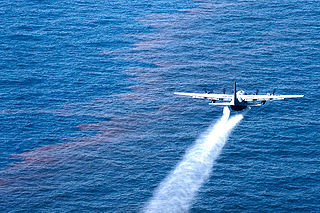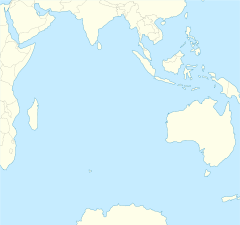
The Gulf of Thailand, also known as the Gulf of Siam, is a shallow inlet in the southwestern South China Sea, bounded between the southwestern shores of the Indochinese Peninsula and the northern half of the Malay Peninsula. It is around 800 km (500 mi) in length and up to 560 km (350 mi) in width, and has a surface area of 320,000 km2 (120,000 sq mi). The gulf is surrounded on the north, west and southwest by the coastlines of Thailand, on the northeast by Cambodia and the Mekong Delta region of Vietnam, and opens to the South China Sea in the southeast.

Rayong Province is one of seventy-six provinces (changwat) lies in eastern Thailand. Neighboring provinces are Chonburi, and Chanthaburi. To the south is the Gulf of Thailand.

Rayong is a city on the east coast of the Gulf of Thailand and the capital of Rayong Province. It covers tambons Tha Pradu and Pak Nam and parts of tambons Choeng Noen and Noen Phra, all within Mueang Rayong District. As of 2016 the population was 64,256 (est.). The main industry is fishing, and it is also the main producer of Thailand's fish sauce. It is also the center of the chemical and auto industries. In 2012 Ford Motor Company opened an assembly plant in Rayong to expand Ford's presence in the ASEAN area, employing some 2,200 people.

Ko Samet is one of the eastern seaboard islands of Thailand. It is in the Gulf of Thailand off the coastline of the Thai province of Rayong, approximately 220 kilometres (140 mi) southeast of Bangkok. Ko Samet is part of the Phe Subdistrict of the Amphoe Mueang Rayong, of Rayong Province. Ko Samet is the largest and westernmost of a cluster of islands not far from the coast. Ko Samet measures 6.8 kilometres (4.2 mi) from north to south. At its closest point to the mainland, the island is 2.6 kilometres (1.6 mi) south of mainland Rayong Province; however the actual travelling distance from the main commercial tourist pier in the town of Phe to the island's closest tourist beach is about 10 kilometres (6.2 mi).

PTT Public Company Limited or simply PTT is a Thai state-owned SET-listed oil and gas company. Formerly known as the Petroleum Authority of Thailand, it owns extensive submarine gas pipelines in the Gulf of Thailand, a network of LPG terminals throughout the kingdom, and it is involved in electricity generation, petrochemical products, oil and gas exploration and production, and gasoline retailing businesses. The company also owns Café Amazon, a popular coffee chain throughout South East Asia, which shops are often located next to PTT gas stations or inside malls.

Mueang Rayong is the capital district of Rayong Province, Thailand. The provincial administration is in Tambon Map Ta Phut.

Khao Laem Ya–Mu Ko Samet is a Thai marine national park in the Gulf of Thailand off the coastline of Rayong, approximately 180 km southeast of Bangkok.
The eastern seaboard of Thailand, more frequently known as the "Eastern Economic Corridor" (EEC), is a developing economic region which plays a key role in Thailand's economy. It is Thailand's center for export-oriented industries. High value goods, such as Japanese branded automobiles, which are manufactured there and shipped elsewhere, are among the many exports. The region includes Chonburi Province, Chachoengsao Province, and Rayong Province with Samut Prakan Province on the periphery.

Petroleum Authority of Thailand Rayong Football Club, also referred to as simply PTT Rayong, was a Thai professional football club based in Rayong Province. They play in Thai League 1 until 2019 after promotion as runner-up in 2007 from the Thailand Division 2 League. PTT FC is a company-sponsored sports club owned by the PTT Public Company Limited.

Corexit is a product line of oil dispersants used during oil spill response operations. It is produced by Nalco Holding Company, an indirect subsidiary of Ecolab. Corexit was originally developed by the Standard Oil Company of New Jersey. Corexit is typically applied by aerial spraying or spraying from ships directly onto an oil slick. On contact with the dispersant, oil that would otherwise float on the surface of the water is emulsified into tiny droplets and sinks or remains suspended in the water. In theory this allows the oil to be more rapidly degraded by bacteria (bioremediation) and prevents it from accumulating on beaches and in marshes.

The Map Ta Phut Industrial Estate is a large industrial park in the town of Map Ta Phut in Rayong Province, Thailand. Part of Thailand's eastern seaboard economic region, it is the country's largest industrial estate and the world's eighth-largest petrochemical industrial hub. It was opened in 1990 and is managed by the Industrial Estate Authority of Thailand, a state enterprise under the Ministry of Industry.
Map Ta Phut is a town in Rayong Province, Thailand. It is the site of Thailand's largest industrial park, the Map Ta Phut Industrial Estate. Provincial offices are in Map Ta Phut.

Ko Pha-ngan Airport is an unfinished airport that was under construction in 2012–2015 on Ko Pha-ngan, Surat Thani Province, Thailand. The airport was being built by Kan Air, a domestic Thai airline, who were reportedly spending 700-900 million baht. Kan Air planned to introduce flights to Ko Pha-ngan's neighboring islands, Ko Samui and Ko Tao, as well as three 80-minute flights daily to and from Bangkok's Don Mueang Airport. Construction was suspended indefinitely due to alleged violations of the law.

The Deepwater Horizon oil spill occurred between 10 April and 19 September 2010 in the Gulf of Mexico. A variety of techniques were used to address fundamental strategies for addressing the spilled oil, which were: to contain oil on the surface, dispersal, and removal. While most of the oil drilled off Louisiana is a lighter crude, the leaking oil was of a heavier blend which contained asphalt-like substances. According to Ed Overton, who heads a federal chemical hazard assessment team for oil spills, this type of oil emulsifies well. Once it becomes emulsified, it no longer evaporates as quickly as regular oil, does not rinse off as easily, cannot be broken down by microbes as easily, and does not burn as well. "That type of mixture essentially removes all the best oil clean-up weapons", Overton said.

Susan D. Shaw is an American environmental health scientist, explorer, ocean conservationist, and author. A Doctor of Public Health, she is a professor in the Department of Environmental Health Sciences at the School of Public Health at the State University of New York at Albany, and Founder/President of the Shaw Institute, a nonprofit scientific institution with a mission to improve human and ecological health through innovative science and strategic partnerships. Shaw is globally recognized for pioneering high-impact environmental research on ocean pollution, climate change, oil spills, and plastics that has fueled public policy over three decades. In 1983, with landscape photographer Ansel Adams, she published Overexposure, the first book to document the health hazards of photographic chemicals. Shaw is credited as the first scientist to show that brominated flame retardant chemicals used in consumer products have contaminated marine mammals and commercially important fish stocks in the northwest Atlantic Ocean. She became the first scientist to dive into the Gulf of Mexico oil slick following the 2010 BP Deepwater Horizon oil rig explosion to investigate the impacts of chemical dispersants used in response to the spill.
The Petrotrin oil spill was a series of oil spills that occurred on the island of Trinidad and Tobago.
The year 2013 was the 232nd year of the Rattanakosin Kingdom of Thailand. It was the 68th year in the reign of King Bhumibol Adulyadej, and is reckoned as year 2556 in the Buddhist Era. The year saw the beginning of protests against Prime Minister Yingluck Shinawatra's government which led to a state of political crisis and the dissolution of government.
Khun Ying Thongtip Ratanarat is a Thai chemical engineer. She is a member of the Board of Directors of The Siam Fine Chemicals and of the Foundation for the Petroleum Institute of Thailand (PTIT). From 1985 to 2005 she was the PTIT's executive director.

Ko Man Nok is a small private island, among a group of islands in the Klaeng Bay, Rayong Province, Thailand, called Man. The group includes Ko Man Nai, Ko Man Klang and Ko Man Nok islands. Ko Man Nok is approximately 0.2 square kilometres (0.077 sq mi) in size, and about 20 nautical miles away from Koh Samet, a 2½ hours journey from Bangkok. Ko Man Nok has only one resort, Koh Munnork Resort.

The Bangkok–Nong Khai high-speed railway or Northeastern high-speed rail line is a high-speed railway under construction in Thailand. It is the first high-speed line in Thailand and constituent part of the Kunming–Singapore railway Central section. Its first phase, between Bangkok and Nakhon Ratchasima, is due to open in 2023, however, in July 2021, authorities said that "works which will have to be postponed are the [... tracks] between Nawa Nakhon and Ban Pho, between Phra Kaeo and Saraburi"; furthermore another postponement, "presumably until [... 2022 is] the section between Don Muang and Nawa Nakhon". As of March 2021, the entire route is expected to be up and running by 2030 at the latest.

















